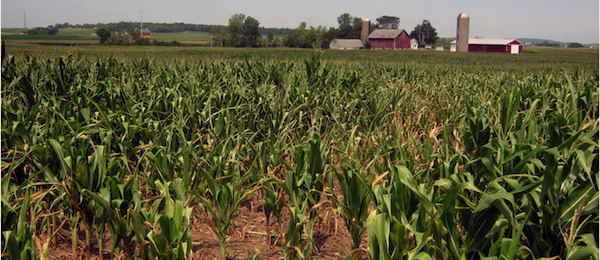news
![]()
August 31, 2015
High water tables can be a boon to crop yields

 High water tables can be a bane to crop yields, compelling many farmers to drain their fields so their crops don’t drown when it rains.
High water tables can be a bane to crop yields, compelling many farmers to drain their fields so their crops don’t drown when it rains.
But a high water table may not always be a bad thing. A new study from the University of Wisconsin-Madison's Water Sustainability and Climate project shows it is actually a boon for some fields and during certain times of the growing season, casting light on opportunities for improving yield efficiency to meet global food demands.
The researchers found high water tables, which are common in Wisconsin and the greater Midwest, can provide much-needed water during drought and to crops planted in coarse-grained soils, such as those in Wisconsin’s Central Sands, which have a harder time retaining water than their fine-grained counterparts, like silt loam.
“Every soil type has a sweet spot in terms of the optimum water table depth for the highest crop yield,” explains lead author Samuel Zipper, a graduate student in the Freshwater and Marine Sciences Program in the College of Engineering, who says their study is the first to look at the interactions between water table depth, soil texture and weather.
Timing, too, is everything.
While rains early in the growing season can waterlog fields, a high water table becomes an advantage later in the season, when the weather is drier and crops need the extra water to pollinate and produce grain.
In fact, Zipper found the benefits of a high water table, also called shallow groundwater, often outweighed the costs for crops in the coarse-grained soils and even many of the fine-grained soils in their study site, rendering higher crop yields, or “groundwater yield subsidies.”
“Surprisingly, even in a wet year, the net benefits of shallow groundwater outweighed the losses,” says Zipper.
A significant roadblock to efficiently feeding the world’s growing population is the “yield gap,” when crop yields don’t meet their full potential. Stress from either too much water or not enough is one of the factors that can lead to shortfalls.
Zipper says a better understanding of how groundwater depth, soil texture and the weather interact to affect crop yields can help farmers determine optimal field-draining depths that will help yields reach their full potential.
By comparing fields’ yield performance in wet and dry years and connecting results to water table depth and soil texture, co-author Steven Loheide, an associate professor of civil and environmental engineering, explains they were able to map more precisely where fields are sensitive to drought or waterlogging and why, a technique with implications for precision agriculture.
“Our data showed that small patches of the field, separated by just tens of meters, have strikingly different sensitivities to drought due to variations in groundwater depth and soil texture,” says Loheide.
Such knowledge could help farmers better invest their resources and target areas that should perform well, especially as extreme weather becomes more common.
“In the long term, farmers should be able to look at the general forecast for a season, decide what to plant where and control groundwater levels to meet crop needs,” says Zipper.
The study was published in the journal Water Resources Research.


